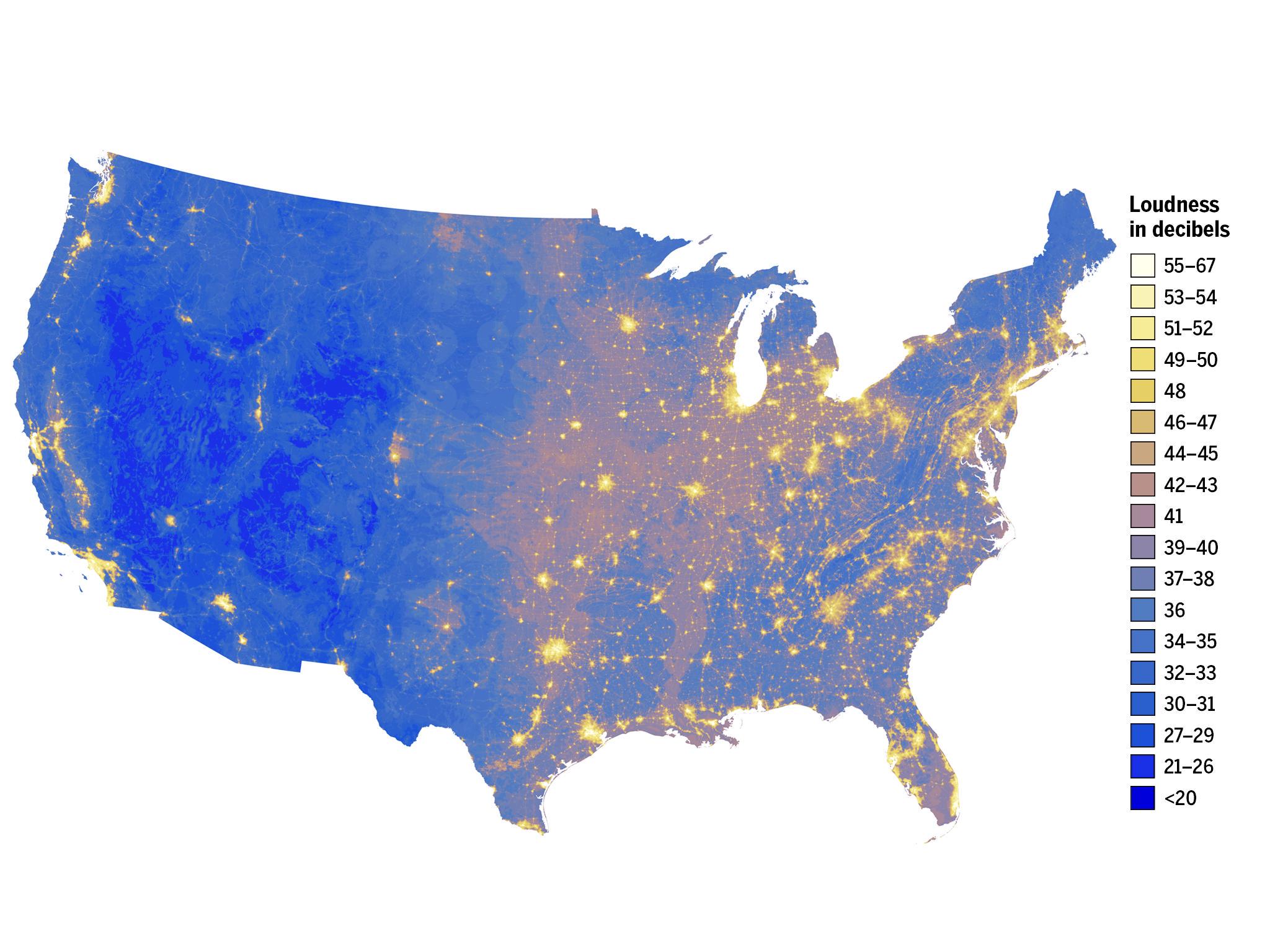Noisiest and Quietest Areas in the US Map


Marcus Rodriguez
Historical Geography Expert
Marcus Rodriguez specializes in historical cartography and geographic data analysis. With a background in both history and geography, he brings unique...
Geographic Analysis
What This Map Shows
The 'Noisiest and Quietest Areas in the US' map offers a vivid representation of the sound levels across the United States. Bright yellow and white areas highlight the loudest regions, often bustling major cities like New York City and Los Angeles, where the hum of urban life creates a constant background noise. In stark contrast, the deep blue patches signify the quietest locales, including serene spots such as Yellowstone National Park and the Great Sand Dunes in Colorado. These tranquil areas, often situated in remote valleys between mountain ranges, provide a striking visual contrast to the cacophony of urban centers.
But rather than focusing solely on the visualization, let’s delve deeper into the intriguing topic of soundscapes across the country, exploring what contributes to these disparities in noise levels.
Deep Dive into Soundscapes
Soundscapes encompass the acoustic environment of a particular area, shaped by both human activity and natural elements. In urban settings, noise pollution is a significant factor, primarily driven by transportation, construction, and social activities. For instance, the clamor of traffic in cities like New York, where an estimated 8.5 million people live, generates a staggering amount of sound, often exceeding 85 decibels during peak hours. This level of noise can have various impacts, from increased stress levels among residents to disruptions in sleep patterns and even contributing to health issues over time.
Conversely, the quietest areas in the United States are often found in places where human presence is minimal. National parks such as Yellowstone, which spans over 3,400 square miles, are designed to protect natural ecosystems and provide an escape from urban noise. Interestingly, research indicates that these quieter regions are not only more pleasant for visitors but also beneficial for wildlife. Many animals rely on sound for communication, and reduced noise pollution allows them to thrive in their natural habitats.
Beyond national parks, remote valleys nestled in the Rocky Mountains and Sierra Nevada also showcase incredibly low sound levels. For example, the Great Sand Dunes National Park in Colorado features windswept dunes, and its isolation contributes to its peaceful ambiance. Sound levels in these areas can drop to as low as 20 decibels, comparable to a whisper, providing a stark contrast to bustling urban centers.
Regional Analysis
Examining the map further, we can identify several regions that illustrate the noise disparity effectively. In the Northeast, cities like Boston and Philadelphia are among the noisiest, with constant movement and activities contributing to a vibrant yet loud atmosphere. These cities are often characterized by their dense populations and extensive public transport systems, which, while efficient, add to the soundscape.
Moving westward, we find the iconic cities of Los Angeles and San Francisco, both notorious for their high noise levels due to traffic congestion and entertainment activities. Los Angeles, with its sprawling neighborhoods and significant car dependency, sees noise pollution levels that can have profound effects on the community's quality of life.
On the other end of the spectrum, the states of Wyoming and Montana, particularly areas like the Absaroka-Beartooth Wilderness, stand out for their tranquility. These regions are less populated, with vast stretches of wilderness that are often untouched by human noise. The Great Basin region, too, is home to some of the quietest places in the country, where you can truly experience the soothing sounds of nature.
Significance and Impact
Understanding the differences in noise levels across the United States is essential for several reasons. Firstly, it highlights the impact of urbanization on health and well-being, emphasizing the need for sustainable urban planning that considers sound pollution as a critical factor. As cities continue to grow, strategies to mitigate noise, such as creating green spaces and implementing sound barriers, are crucial.
Moreover, recognizing the value of quieter regions can promote conservation efforts. The serenity found in places like Yellowstone not only benefits human visitors but also supports biodiversity by allowing wildlife to flourish. With increasing urban sprawl and climate change, preserving these quiet areas becomes ever more important.
Finally, as more people seek refuge from the noise of city life, trends show a growing interest in ecotourism and outdoor activities. This shift has implications for local economies and conservation initiatives, as communities recognize the value of their natural soundscapes.
By examining the noisiest and quietest areas in the US, we gain insights into how sound shapes our environments and experiences. It’s a reminder of the diverse acoustic landscape that defines this vast country, urging us to appreciate both the vibrant sounds of urban life and the tranquil whispers of nature.
Visualization Details
- Published
- October 13, 2025
- Views
- 60
Comments
Loading comments...